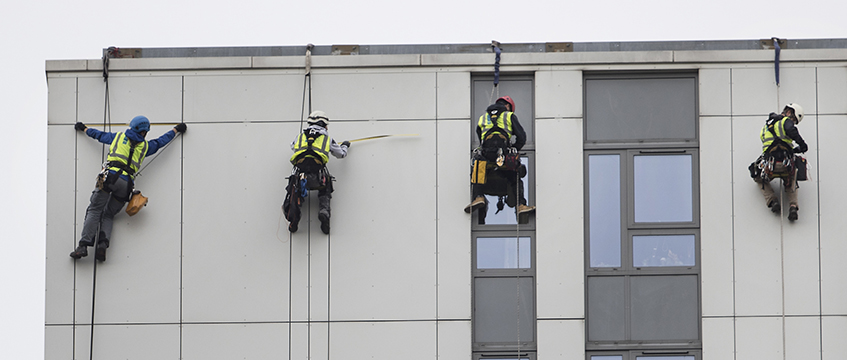Cladding concerns spread to private sector
Hundreds of hotels, private sector blocks and student housing blocks previously declared safe following the Grenfell Tower tragedy may have to have their cladding replaced.
The National Housing Federation has this week called on the government to stop cladding tests and instead get on with making all towers across the public and private sectors safe.
All of the towers so far examined have failed the test.
Hundreds of hotels, private sector blocks and student housing blocks previously declared safe following the Grenfell Tower tragedy may have to have their cladding replaced.
The National Housing Federation has this week called on the government to stop cladding tests and instead get on with making all towers across the public and private sectors safe.
All of the towers so far examined have failed the test.
According to property consultancy Gleeds, the cost of replacing the cladding on public buildings alone could top £12bn. With private sector blocks, hotels and student accommodation added to that, the total will be much higher.
Prime minister Theresa May has launched a “major national investigation” into the fallout from the Grenfell tragedy and a judge, Sir Martin Moore-Pick, has this week been appointed to lead the inquiry into the disaster. The Department for Communities and Local Government, which has so far carried out free tests on cladding samples from 120 buildings more than 18m high, reported none had met the required combustibility standards.
Unsafe material
This week, for the first time, DCLG has said some private blocks were now included in that total. The Association of Residential Managing Agents said one of its largest members – accounting for 10% of members’ stock – had reported that all 60 of the blocks it had tested were wrapped in the unsafe material.
The Home Builders Federation and the British Property Federation have confirmed that members are sending samples to the DCLG, while others carry out independent audits.
The Housing & Finance Institute this week called for no new tower block construction to begin until safety can be assured. The HFI wants a review into the future of existing high-rise blocks to consider whether they should be demolished instead of repaired.
The government is refusing to give an official line on its expectations from the private sector. BPF chief executive Melanie Leech said: “Most of the nation’s focus has thus far been on the social housing sector.
“However, the private sector operators we know are being proactive in examining the materials and construction methods they have used, and that includes in the commercial sector. Where they feel there is the slightest doubt, they have pursued more thorough investigations.”
Simultaneously, house builders are carrying out audits, according to Steve Turner, a spokesman for the HBF. He said: “Every company will be doing it. Clearly there’s been a failure and our members are doing audits of what they’ve got and what they’ve built.”
He added builders were talking to management companies at tower blocks they had developed about whether or not cladding has been added after completion.
Nigel Gibson, chief executive of the Association of Residential Managing Agents, said: “The private sector might have been quiet, but we have been beavering away in the background.” He said members had been sharing fire safety information, because there is no competitive advantage to having better fire safety measures.
Fragmented picture
The picture is fragmented across the country, however, and there is no co-ordinated private sector initiative to check the safety of buildings. ARMA, for example, only has half of the residential management sector under its auspices, and because it is an unregulated sector, there is no way of checking that the other half of the sector is voluntarily verifying the safety of its buildings.
Ultimately, liability will depend on the specifics of a range of contractual agreements between a developer, its contractors and the lessees.
According to David Savage, partner and head of the construction sector at law firm Charles Russell Speechlys, a key issue here is whether existing structures are genuinely non-compliant with existing regulations, or whether they only become so via new higher standards when introduced and applied retrospectively.
If non-compliant at the time, then the number of buildings already showing up having unsafe cladding indicates that there could be a massive fallout and years of litigation.
In that case, if a residential developer is still a freeholder, for instance, then it will have a duty to comply with the Housing Health and Safety Rating System, which requires that there should be no unacceptable level of risk to the health and safety of the occupiers or their visitors. This, and several other legal obligations around duty of care, exist for an unlimited time on the landlord.
Design flaw
If it is found that there were mistakes in the building of the block itself, then it will either be a design flaw – in which case designers and engineers will likely be covered by insurance – or a mistake by the contractor. Some or all of these problems may be covered by warranty.
If the government finds that in fact no rules were broken in the use of the cladding, then it will have to tighten building regulations. However, if it tries to do this retrospectively, it is unclear who would ultimately pay to have hundreds of existing buildings UK-wide upgraded.
The government’s tests
At the heart of the matter is the exact flammability of the material used to clad a tower block. The detail here is technical but important: it will determine exactly who in the supply chain is responsible for any defects – from developer through to contractor, sub-contractor or architect – or whether the building regulations and enforcers themselves are at fault.
The material used at Grenfell, which had an outer layer of aluminium with a layer of polyethylene inside it, is B rated according to a part of building regulations called Approved Document B which governs fire safety. In tower blocks of 18m or more, a higher A2 rating is required by that document, to avoid blazes spiralling upwards through a building.
The crucial question mark then hangs over whether or not the use of this material constitutes an infringement of existing building regulations at that time. Niall Rowan, chief operating officer at the Association for Specialist Fire Protection, says the NHBC and others have been lax in their enforcement.
In bald terms, using polyethylene would appear to be an infringement, but builders have arguably been let off the hook for using this material as one element of a wider fire safety system, rather than as a single component.
All this is significant because any liability for breach of regulations will be judged by the building regulations that existed at the time of installation.
It is possible that the government is now effectively testing for A2 rated materials when B rated materials may have passed the test previously. If this is the case, the government will have to tighten building regulations, but it would be tough to do so retrospectively, as the private sector could force government bodies to shoulder the cost of retrofitting – a mammoth, not to mention expensive, task.
There are other variables at stake, beyond the aluminium cladding that has dominated headlines.
Only 18 of more than 2,000 social housing tower blocks contain sprinklers, for example. There is also the possibility that the Grenfell fire happened as a result of contractor failings and had nothing to do with materials: it may be that the contractor failed to “compartmentalise” the flats with fire-stopping materials between panels of cladding, meaning fire was allowed to spread upwards.
In short, the government is crudely testing for the use of a substance that may or may not have been legitimately used. It has made the cladding into a lightning rod. “The government is doing a simple cladding test and it doesn’t work: we need to look at the whole thing holistically,” says Rowan.
If the government sticks to its present line, then it will have to modify building regulations. And that can of worms is only just beginning to present itself to the property industry.
To send feedback, e-mail nick.johnstone@egi.co.uk or tweet @n_johnstone or @estatesgazette
Image: MacDiarmid/REX/Shutterstock











